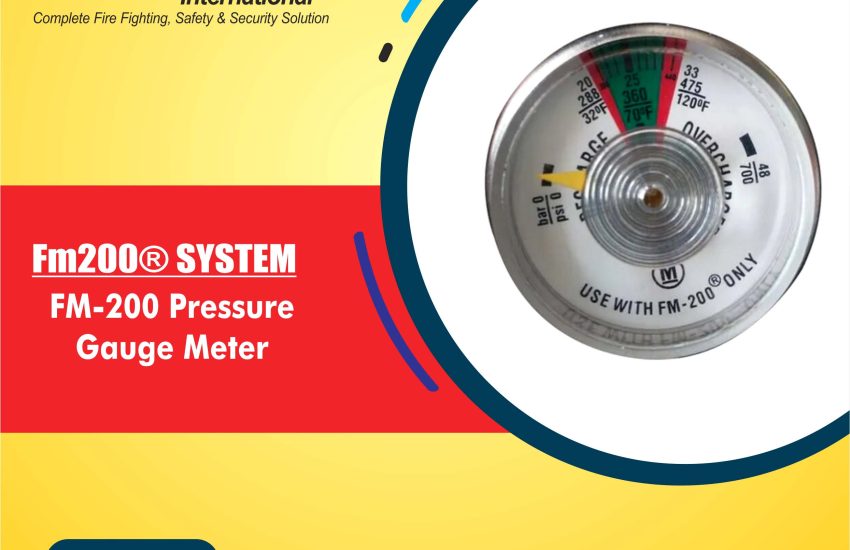FM-200 Pressure Gauge Meter FM-200 is a popular clean agent for fire suppression systems. It effectively protects sensitive equipment such as computers, electrical panels, and server rooms. A critical component of the FM-200 system is the pressure gauge meter. This device ensures that the system is charged and ready to activate in case of a fire. In this guide, we will explore everything you need to know about the FM-200 pressure gauge meter, including its function, features, and maintenance.
What is an Pressure Gauge Meter?
The pressure gauge meter measures the pressure of the FM-200 gas inside the fire suppression system’s cylinder. It provides real-time feedback on the pressure level, helping you ensure that the system is fully charged. If the pressure falls below the required level, the meter will signal the need for a recharge or maintenance. This allows you to keep the system in top working condition, so it will perform when needed most.
Key Features of the Pressure Gauge Meter:
- Accurate Pressure Readings: The pressure gauge meter offers precise pressure readings, ensuring your FM-200 system stays properly charged.
- Durability: Designed to withstand high-pressure conditions, the pressure gauge meter is built to last.
- User-Friendly: The clear and easy-to-read display ensures quick pressure checks, making system maintenance straightforward.
How Does an Pressure Gauge Meter Work?
The pressure gauge meter measures the pressure exerted by the FM-200 gas within the cylinder. The meter displays the gas pressure level. If the pressure is too low, the system might not function correctly during an emergency. The meter’s readings will alert you to any issues that may require attention, such as a leak or a need for recharging the gas.
- High Pressure: When the FM-200 system is fully charged, the gauge will show high pressure.
- Low Pressure: If the pressure drops below a certain threshold, the gauge will indicate that the system needs recharging.
Why is the Pressure Gauge Meter Important?
The pressure gauge meter ensures the fire suppression system is always ready to protect your valuable assets. Regularly monitoring the pressure helps you avoid unexpected failures during emergencies. Here’s why the meter is essential:
1. Ensures System Readiness: Regular pressure checks help you detect potential issues, such as leaks or low gas levels, before they compromise system performance.
2. Supports Compliance with Safety Regulations: Most fire safety standards require you to keep the FM-200 system in good condition. The pressure gauge meter helps you stay compliant with these regulations.
3. Prevents System Failures: Low pressure can result in system failure. By using the pressure gauge, you can maintain the proper pressure levels to ensure effective suppression when needed.
Types of Pressure Gauge Meters
FM-200 pressure gauges come in various types to suit different needs. Some common types include:
1. Analog Pressure Gauges: These traditional gauges feature a needle that points to the pressure reading. They are simple, reliable, and cost-effective.
2. Digital Pressure Gauges: Digital gauges provide a more precise reading, often offering additional features like alarms or data logging.
3. Compound Pressure Gauges: These gauges measure both positive and negative pressures. They are ideal for systems that experience varying pressure levels.
How to Read an Pressure Gauge Meter
Reading the pressure gauge meter is straightforward. Look for the following key zones on the gauge:
- Green Zone: This indicates that the system is fully charged and ready to use.
- Yellow Zone: If the needle falls into the yellow zone, the pressure is low. You may need to perform maintenance.
- Red Zone: A red zone reading signals a critical issue, such as a significant loss of gas. Immediate attention is required.
FM-200 Pressure Gauge Meter Maintenance
To ensure that your pressure gauge meter continues to provide accurate readings, follow these maintenance tips:
1. Inspect Regularly: Perform routine inspections to ensure that the gauge is working properly. Check for visible damage or wear.
2. Look for Leaks: Leaks in the system can cause the pressure to drop. Regularly check for signs of gas leaks.
3. Calibrate the Gauge: Periodically calibrate the pressure gauge to maintain accuracy.
4. Replace Faulty Gauges: If the gauge is malfunctioning or damaged, replace it promptly to avoid inaccurate readings.
Benefits of the FM-200 Pressure Gauge Meter
The pressure gauge meter offers several advantages:
- Real-Time Monitoring: Continuously track the pressure level to ensure the system’s readiness.
- Enhanced Safety: Regular pressure checks help prevent system failures that could compromise safety.
- Preventative Maintenance: Early detection of pressure issues allows for timely repairs and reduces the risk of costly system failure.
- Compliance: Keep your FM-200 system compliant with safety regulations and industry standards.
Conclusion
FM-200 Pressure Gauge Meter is a vital component of any FM-200 fire suppression system. It ensures that the system remains fully charged and ready to activate when necessary. By regularly monitoring and maintaining the pressure gauge, you can prevent system failures and stay compliant with fire safety regulations. Understanding how to use and care for the pressure gauge will help you protect your valuable assets and improve overall fire safety.


